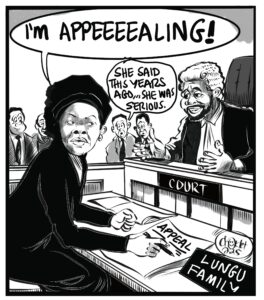A University of Zambia chief security officer has narrated to the Lusaka Magistrates’ Court events which led to the death of Vespers Shimunzhila last year, reiterating that the latter lost her life due to carbon monoxide poisoning.
Bwalya Kalebaila told the court that when he visited Vesper’s room, it was very hot and choking with smoke coming from the fire and teargas canisters.
This is an inquest to ascertain how the UNZA student came to her death.
Vespers, who was a fourth year student at UNZA died in October last year of suffocation after police allegedly burnt one of the hostels using a tear gas canister during a student riot over delayed payment of meal allowances.
The interested parties in this matter include; Vespers’ parents, uncle, grandfather and her three roommates.
When the matter came up for hearing, Monday, magistrate Silvia Munyinya informed the interested parties that they had the right to be represented by a lawyer in the inquiry.
At this point, the coroner called the first witness, Vespers’ uncle Panister Shimunzhila, a 48 year-old farmer, who told the court that on October 7, 2018, he identified Vespers’ body at UTH before postmortem was conducted.
When he was asked by a lawyer representing Vespers’ parents, Lastone Mwanabo on the results of the postmortem, Panister told the court that according to what he read from the report, Vespers died as a result of suffocation.
The second witness was 44 year-old Bwalya Kalebaila, a Chief Security Officer at UNZA who told the court that on October 4, last year, he was notified that there was a protest within the campus over alleged delayed payments of meal allowances.
He narrated that he called an officer identified as Benjamin Ngwira and informed him of the unrest, and the officer promised to mobilise officers.
Kalebaila said he also called the deputy Criminal Investigations Officer for Chelston Police Station.
He told the court that while majority of the students were inside the campus on the material day, a few students were burning tyres on Great East Road.
“At this point, I received a phone call from the officer in charge at Chelstone police who told me that he had assigned his deputy, Mr Kumwenda to be the commander or in charge of officers by the roadside. He indicated that he had quenched a few fires from the road side. He further indicated that his team would monitor the situation from the outside and he told me that we should be on the look out from the inside,” he said.
The witness said when the situation inside the campus was calm, he heard some gunshots from the roadside which caused a lot of excitement among students.
He said he then pleaded with the officer to stop firing because the gun shots were exciting the students.
Kalebaila said around 00:50 AM, he saw a police vehicle, a green Nissan, coming in from the Great East Road and the officers in there started firing teargas canisters from the vehicle.
He added that when he went to look for a senior officer to ask the police officers in the green Nissan to stop firing teargas canisters, his deputy called him saying there was a fire at the hostels.
“I went back to the road side so that I could engage officers from the road side. As I was talking to him, my deputy, miss Mulenga rushed to the road side that there was fire. I rushed to the scene and found one of the rooms at October two hostel on the upper floor was gutted,” he said.
“The first time I went there (at the hostels) there were some students that were trying to quench the fire and rescue some students who were inside. [However] when I went back [for the second time] I found that the students had scampered. My deputy told me that police officers had come and were firing teargas canisters towards the rooms, to disperse the students. According to my deputy, in the process one of the lower rooms at October two room three was also gutted. At this time, there were still some courageous students that were trying to quench the fire.”
Kailebaila said when he went to inspect the rooms at the October hostel with the Vice Chancellor and some students, the burnt rooms were very hot and choking.
“I accompanied the VC, the first room was room 21, October two. The room was very hot and choking, both teargas canister smoke and ordinary smoke from the fire. I could feel it even on my skin. The clothes and mattresses were burnt. We were led by the VC to other rooms, generally it was a choking atmosphere. When we went to room 25 [Vespers’ room] which appeared on the receiving end, where the smoke was going, it was choking,” he said.
Meanwhile, Kailebaila said he was informed by a female medical officer at Levy Mwanawasa Teaching Hospital that Vespers’ cause of death was carbon monoxide or carbon dioxide poison.
He added that during investigations, 26 shells of teargas canisters were picked and handed over to the police.
The matter comes up on March 1 for continued hearing
























